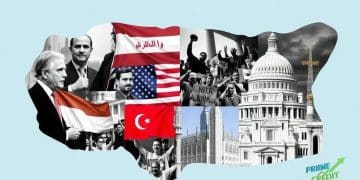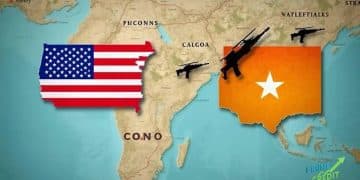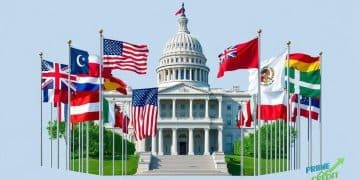Debates over U.S. negotiations with Iran: what’s at stake?
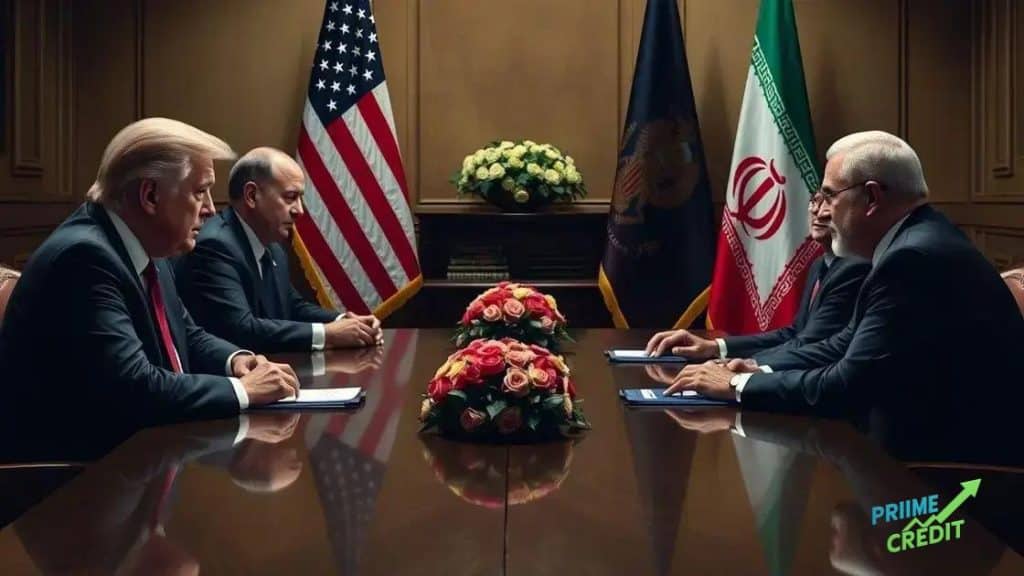
Debates over U.S. negotiations with Iran involve complex factors such as historical tensions, key players, and potential outcomes, impacting regional stability and global economic dynamics significantly.
Debates over U.S. negotiations with Iran are not just political chatter; they shape international relations and impact our daily lives. Have you ever wondered how these discussions influence global peace and security?
Historical context of u.s.-iran relations
The historical context of U.S.-Iran relations is complex and charged with events that have shaped both nations’ interactions over the decades. Understanding this backdrop is essential to grasp the current debates on negotiations.
Since the early 20th century, U.S. involvement in Iran has been significant. The 1953 coup, which reinstated the Shah, marked a turning point in this relationship. This event still resonates in Iranian politics and public sentiment today.
Key Events Shaping Relations
Several key events have defined the trajectory of these two nations:
- The 1979 Iranian Revolution disrupted U.S.-Iran ties dramatically.
- The Iran Hostage Crisis further escalated tensions.
- Economic sanctions imposed by the U.S. transformed diplomatic engagement.
In recent years, attempts to negotiate nuclear agreements highlighted both opportunities and challenges. The Joint Comprehensive Plan of Action (JCPOA), agreed upon in 2015, was seen as a pivotal moment for potential reconciliation.
However, the U.S. withdrawal from this agreement in 2018 led to heightened hostilities and renewed sanctions. This cycle of action and reaction has created a climate of distrust that complicates future negotiations.
It’s vital to acknowledge that the historical context also involves the voices of the Iranian people who have experienced the impact of foreign policy decisions first-hand. Understanding their perspective is crucial in framing any diplomatic efforts.
The Impact of History on Current Negotiations
The legacies of past events continue to fuel debates over U.S. negotiations with Iran. Leaders on both sides must navigate a deeply rooted landscape of mutual suspicion and nationalism, which complicates their paths forward.
Key players in the negotiations
Understanding the key players in the negotiations between the U.S. and Iran is essential for grasping the complex dynamics at play. Each participant has their own goals and influences that shape discussions.
The major players include not only the governments of the U.S. and Iran but also other nations and organizations that play a significant role. Their involvement can often sway the outcome of negotiations.
The United States
The U.S. government, specifically the president and the Secretary of State, are vital in shaping foreign policy. The U.S. aims to ensure national security and prevent nuclear proliferation in Iran.
Iran
On the Iranian side, the Supreme Leader and the president play crucial roles in defining the country’s stance. Iran seeks recognition and the lifting of sanctions that have crippled its economy.
- Different factions within Iran, such as reformists and hardliners, influence the negotiation process.
- Public opinion in Iran impacts the government’s approach to negotiations.
- Tehran’s history and regional ambitions also shape its negotiation strategies.
Additionally, other countries, including European nations and Russia, often act as intermediaries or support various facets of the talks. These actors can provide different perspectives and solutions to the ongoing challenges, adding complexity to the discussions.
International organizations like the United Nations also have a stake in the outcomes, emphasizing diplomacy and peacekeeping efforts. The influence of these players can change based on the political climate, which further complicates negotiations between the U.S. and Iran.
Main challenges faced in talks
The main challenges faced in talks between the U.S. and Iran are numerous and complex. These obstacles can derail negotiations and impact the overall stability of the region.
A significant challenge arises from mutual distrust. Both countries have a long history of suspicion and anger towards each other. This distrust makes it difficult for both sides to genuinely believe the other will adhere to any agreements reached.
Sanctions and Economic Pressure
Economic sanctions imposed by the U.S. have severely impacted Iran’s economy, creating additional tensions.
- Sanctions limit Iran’s ability to trade, causing public frustration.
- Iran demands the lifting of sanctions as a condition for nuclear negotiations.
- U.S. leaders often hesitate to ease these sanctions without guarantees of compliance from Iran.
Another challenge is the involvement of various regional powers. Countries like Saudi Arabia and Israel closely monitor the negotiations. Their interests can complicate the talks as they fear a nuclear-armed Iran impacting their national security.
Internal Politics
Internal politics in both countries also play a critical role. In the U.S., political factions have differing opinions on how to handle Iran. Some want to maintain a hardline stance, while others seek diplomatic engagement.
In Iran, the government faces pressure from hardliners who oppose any concessions to the West. This internal strife can hinder progress during negotiations.
Finally, the lack of a clear communication channel adds to the complexity of these discussions. Misunderstandings can easily escalate tensions, causing talks to break down. Navigating these challenges requires skillful diplomacy and a firm commitment from both sides to overcome historical grievances.
Possible outcomes of successful diplomacy
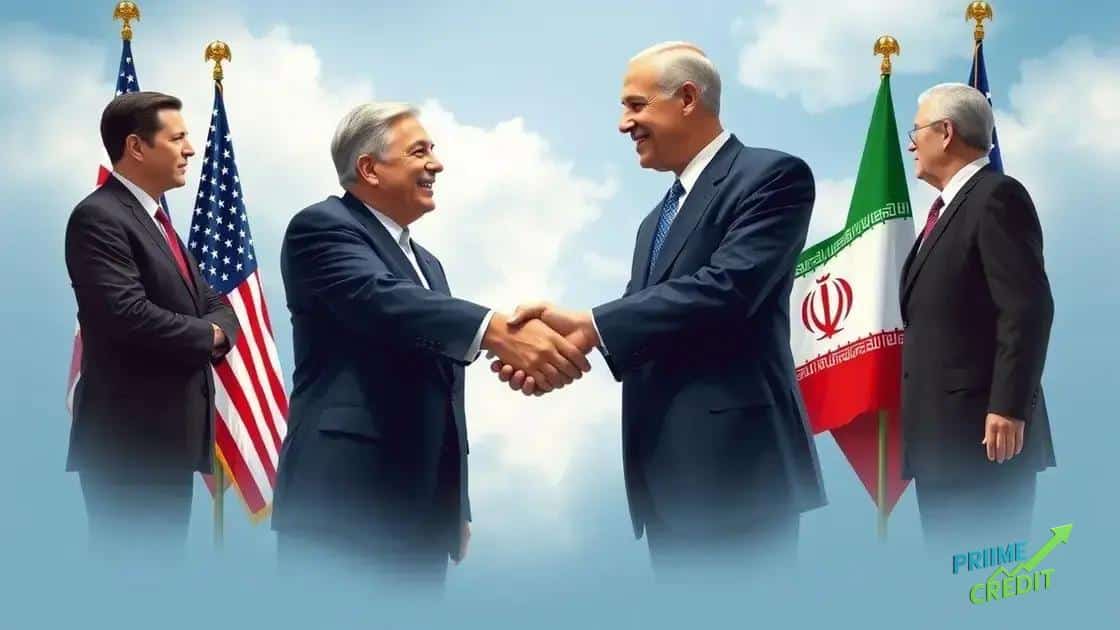
The possible outcomes of successful diplomacy between the U.S. and Iran can significantly impact not only the two nations but also the entire region and the world. When diplomacy succeeds, it opens doors to positive changes.
One of the most notable outcomes is the potential for improved relations. If the U.S. and Iran can reach a comprehensive agreement, it may lead to increased trade and economic cooperation. This could boost Iran’s economy and improve the living standards of its citizens.
Reduction of Tensions
Another important result would be a reduction in military tensions. With successful negotiations, both countries might feel safer and less inclined to engage in military confrontations. This could lead to:
- A decrease in military presence in the region.
- Less likelihood of proxy conflicts in neighboring countries.
- Enhanced stability in the Middle East.
A potential outcome also includes greater collaboration on regional security issues. The U.S. and Iran, working together, could address common threats such as terrorism. This joint effort might create a safer environment that benefits both countries.
Nuclear Non-Proliferation
Successful diplomacy could also lead to better frameworks for nuclear non-proliferation. If Iran complies with measures to limit its nuclear program, it can pave the way for a more secure nuclear landscape. This may build trust among nations and lead to broader disarmament talks.
Finally, successful negotiations may improve public perception. If the governments can demonstrate tangible benefits from diplomacy, it could shift how citizens view each other’s countries. A more positive image might encourage future collaboration and peace.
Impact on global relations and economy
The impact on global relations and economy resulting from U.S.-Iran negotiations is significant and far-reaching. These negotiations can influence not just the two countries involved but also affect international markets and alliances.
First, when the U.S. and Iran find common ground, it can lead to a ripple effect in diplomatic relations. Other nations may feel more secure, encouraging them to engage in trade and diplomatic efforts with both countries.
Trade Relations
The potential for improved trade relations becomes evident. If sanctions are lifted, Iran could re-enter the global market, providing opportunities for:
- Increased oil exports, which may lower global oil prices.
- New investments in various sectors, including technology and agriculture.
- Economic partnerships that can boost both U.S. and Iranian economies.
This economic revival could lead to job creation and improved living standards in Iran, making a positive contribution to global economic stability.
Shifts in Alliances
Diplomatic breakthroughs may also lead to shifts in alliances. Countries that previously aligned against Iran might reconsider their positions, focusing on collaboration rather than conflict. This can promote:
- Strengthening of regional alliances.
- Enhanced cooperation on issues like security and counter-terrorism.
- Increased focus on peace initiatives in the Middle East.
A more stable Iranian government resulting from positive negotiations might contribute to a balanced approach in the region, fostering better relations among Middle Eastern countries and beyond.
In summary, the outcomes of successful U.S.-Iran negotiations can reshape not just their bilateral relations, but also influence market dynamics, international alliances, and overall global peace efforts.
FAQ – Frequently Asked Questions about U.S. Negotiations with Iran
What are the main goals of U.S. negotiations with Iran?
The main goals include ensuring nuclear non-proliferation, reducing tensions, and improving diplomatic relations.
How could successful negotiations impact the global economy?
If negotiations succeed, it could lead to improved trade relations and economic growth for both the U.S. and Iran, benefiting global markets.
What challenges do negotiators face in U.S.-Iran talks?
Challenges include mutual distrust, economic sanctions, and internal political pressures in both countries.
What are the potential benefits of successful diplomacy between the U.S. and Iran?
Benefits may include regional stability, enhanced security cooperation, and positive public perception, fostering future collaboration.
